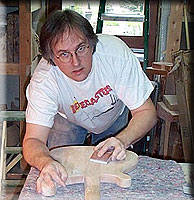While the need to have a Model 4000 Series bass bridge adjusted is instantly recognizable to players, it certainly can be a haunt to the repair bench.
Few repairman or road technicians embrace intonating or strobe tuning Rickenbacker basses with this bridge. Most have become accustomed to the "easy to operate" Fullerton brand.
As there is no apparent after market product or factory alternative, the following modifications provide a most workable solution.
While maintaining the look of the factory original, the following modification has been well received by Rickenbaker bass owners, both
amateur and professional.
Here is a step by step description of the procedure. To begin, I take the bridge base off and remove the mute.
Next, using a round-end carbide down cutter, I mill the teeth notches deeper on the bridge saddle side of the base.
The mill marks are cleaned up with some emory cloth. The saddles are then removed from the bridge chassis. I must remember at this point that I am turning this chassis around when I am done.
Next, I mill off 1/3 of the shaft that hangs into the chassis on the E string, plus I use a square jewelers file to square out the corners of the saddle slot to give maximum travel in the housing.
This was the old 'G' string saddle slot, and soon becomes the new 'E' saddle slot.
|
